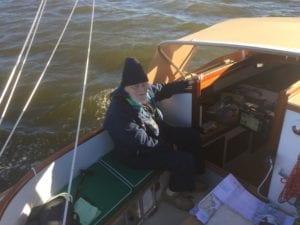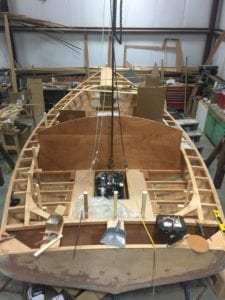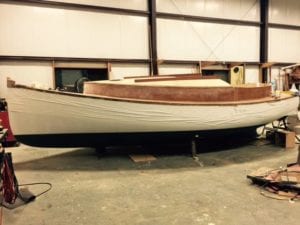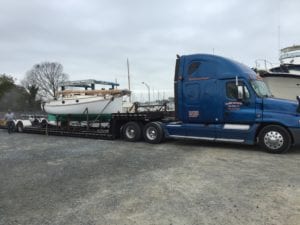The Maiden Voyage of Gracie Anne (Part 1):
The Build
In August of 2014, I received a random call from a gentleman inquiring about our custom 22′ wooden catboat design. We discussed at length her sailing qualities and the shallow water advantages of a catboat. His questions were on target and I sensed he knew what he wanted. A week later, he called again and introduced himself as Winslow Maxwell. We discussed the boat in more detail and Mr. Maxwell explained that he wanted to sail from Nova Scotia to Puerto Rico, mostly via inland routes, but he also wanted to be able to sail 12-18 hour voyages single-handed in the open ocean, particularly in the Gulf of Maine and the Gulf Stream. He verbally committed to the project conditioned on his approval of a written contract. When I asked him about options, he said “design and build the boat as if you were an 87-year old man and were doing this trip single-handed.” I asked for his height and build, he said 6 feet,190 lbs. I asked if he was strong enough to raise a sail. He was a bit annoyed by the question but relented, “of course, but give me a winch.” I asked if there was anything else. “Yes, one other detail, the cushions need to be green with white piping.”

I prepared a contract and sent it out. Weeks went by with no word. As we were preparing the boatbuilding shop for winter builds, which included two 14′ and two 16′ glass-hulled catboats, but no new wooden boat orders, I was getting concerned that I may have to lay off some crew. I had thought the Maxwell contract was a long shot and had not put a lot of stock in the order coming through.
In October, I headed to the Annapolis boat show in Maryland. It had been fifteen years since Arey’s Pond had exhibited there, because my last experience had been frustrating producing no orders. But this show went well, and in fact, later in the month, we did confirm an order for a 16′ Lynx.
Nevertheless, on the drive home, I was not feeling great about the winter ahead. We had a new boatbuilding shop and a great team, but we needed more work. Even with the potential new order, the work load was not going to carry the current crew. I pulled over in New Jersey to take a break, and took a call from our office administrator. She reported to me the messages, and then added that we had received a signed contract and a large deposit from Mr. Maxwell. As the news sunk in, a wave of excitement consumed me. Pulling back onto the highway, it was a new day. We had a huge challenge in front of us, to build a 22′ custom cold-molded catboat in 10 months that could sail, at times offshore, with an 87-year old man single-handing at the helm.

My first call was to our lead boat builder, Leslie Gouveia, letting her know that we had our work cut out for us. My next call was to New Wave Systems concerning some design adjustments that I wanted to make to the hull since our last 22′, which we had built in 2011. I wanted to get the new offsets as fast as possible. My next call was to our mold fabricator to make sure they were on board and ready to go. The last two calls were to Forte Spars (Ledyard CT) and Americas’ Wood (Washington ME). We were going with all carbon spars with a faux varnished look and we were going to strip plank the catboat with 5/8″, tongue and groove, red cedar veneer, vacuum-bagged for frame strength, built on a fir backbone.
By early January 2015, our new 22’ catboat was set up and ready to fit with the keel and centerboard trunk. Bill Nash, a boat builder from Bermuda with a long resume of wooden boat building, was leading, assisted by Alex Finn, who had just finished his schooling at The Northwest School of Wooden Boat Building. Through the planking process, we were not meeting our time milestones, and I was getting concerned. The shop was now busy with other new builds and repairs, so we added more help to get the planking done.
By early June, the boat was flipped over, the bulkhead was installed, and the Yanmar motor was in. We were starting the cockpit framing and deck beams. Mr. Maxwell had been sending his payments in a timely manner, but there had been no more calls and I had not met him.
As the boat yard was getting in full summer swing, we forged on in the boat building shop. My attention was on all of the operations, from service to sailing school to new boat deliveries; and of course the Winslow Maxwell project. It was not until mid-July that I got a call from Winslow saying that he was ready to go and he was headed to the Cape in late August. He was holding me to the 10-month build time, although I explained that realistically, it was going to be 12 months due to the many options he had requested. At the time of his call, the cabin top was on and a lot of the interior had been framed in. We now had Leslie and another boatbuilder on the job full-time and the project was on schedule. In late August, Winslow called again saying that he would arrive in the first week of September. We made plans for him to live at the boat house at our waterfront facility, a one-floor apartment with a pond view, until his boat was finished.

On September 9th, I pulled into the yard to check on things and noticed a car that I did not recognize. I walked into the office and there, sitting in our big comfortable chair, was Winslow Maxwell, with white hair and a scrubby beard, wearing a large overcoat and holding a cane. He had a huge smile on his face. “Hey there, you must be Tony,” we shook hands and he stayed put in the chair as we discussed the boat. He told me about some of his background, including being a part owner of Chris Craft, and about other boats that had been built for him and the many sailing trips he had been on. I invited him to visit his newest project. Winslow could not have been nicer to the crew despite the fact that his boat looked far from done. His closing comment was “I hope we will be sailing before the snow flies.” He stayed in a local hotel until the apartment was free, and once it was, he settled in overlooking Arey’s Pond and planning his trip. We set a test launch date of October 22nd, exactly one year from when we had received the deposit. We were able to meet the date and the test run went well. Winslow kissed the hull as his new boat, Gracie Anne, named after his granddaughter, slid into Areys Pond.
We ran her around the pond to check the engine and trim, and then we moved her back to the shop for final systems, interior details, painting and varnishing. The crew was dedicated and put in long hours, working well into the nights until the boat was finished. In the evenings I had been meeting with Winslow and putting a plan together. I suggested we truck her to Virginia and start the trip there. He insisted on New Jersey, so I picked Hoffmann’s Marina (Brielle NJ). Winslow lined up a truck and on November 18th, we shipped her south. I followed, accompanied by one of our sailing instructors, in one of our trucks loaded with all the rigging. Winslow drove separately in a rented car.
 The great crew at Hoffman’s was there to greet us on our arrival. We launched the boat and stepped the mast after dark. Winslow poured champagne on the stem head and gave her another kiss. She was rigged in the water and on her lines for the first time.
The great crew at Hoffman’s was there to greet us on our arrival. We launched the boat and stepped the mast after dark. Winslow poured champagne on the stem head and gave her another kiss. She was rigged in the water and on her lines for the first time.

We slept aboard, and Winslow stayed in a motel.
Make sure to read the Maiden Voyage of Gracie Anne, Part 2 and Part 3, as well as Part 4, Maiden Voyage for a New Owner.
